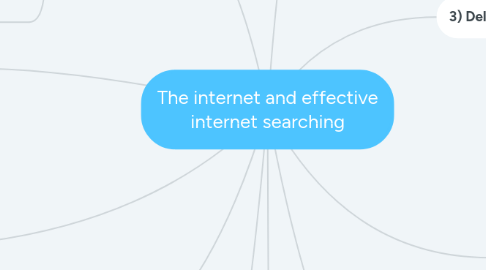The internet and effective internet searching
por Ashleigh Parris

1. 1) Clarify
1.1. Students first need to take a moment to consider what information they’re actually looking for in their searches.
1.2. It can be a worthwhile exercise to add this extra step in between giving a student a task (or choice of tasks) and sending them off to research.
1.3. You could have a class discussion or small group conferences on brainstorming keywords, considering synonyms, generating questions etc.
1.4. Time spent defining the task can lead to a more effective and streamlined research process.
2. 7) Search engines
2.1. Search engines are constantly changing and evolving.
2.1.1. New features are added
2.1.2. Old features are removed
2.2. There are many different search engines that can be used
3. 8) Evaluate the website
3.1. Is it credible?
3.2. Who made the site?
3.2.1. Is the author reliable?
3.3. Is the creator of the site reliable?
4. 9) Trim the URL
4.1. If you trim back the URL you can find more information from the original site you have been using.
5. 10) Similarity
5.1. It is easy to google and find pages similar to the one your using with similar infomrmation
5.2. This can help to find pages that are linked which in turn will give you more information
6. 2) Search
6.1. It sounds simple but students need to know that the quality of the search terms they put in the search box will determine the quality of their results.
6.2. There are a LOT of tips and tricks for Googling but I think it’s best to have students first master the basics.
6.3. There’s lots you can learn about Google searches.
7. 3) Delve
7.1. Entering quality search terms is one thing but knowing what to click on is another.
7.2. You might like to encourage students to look beyond the first few results. Let students know that many websites use Search Engine Optimisation to improve the visibility of their pages in search results. That doesn’t necessarily mean they’re the most useful or relevant sites.
7.3. Point out the anatomy of a Google search result and ensure students know what all the components mean.
8. 4) Evaluate
8.1. Once you click on a site, how do you know if it offers the information you need?
8.2. Students need to know how to search for the specific information they’re after on a website. Teach students how to look for the search box on a webpage or use Control F (Command F on Mac) to bring up a search box that can scan the page.
8.3. Ensure students understand that you cannot believe everything you read. This might involve checking multiple sources. You might set up class guidelines that ask students to cross check their information on two or three different sites before assuming it’s accurate.
9. 5) Cite
9.1. Many students will instinctively want to copy and paste the information they find for their own work.
9.2. Obviously, we need to inform students about plagiarism and copyright infringement while giving them the skills they need to avoid this.
9.3. Give students lots of practice writing information in their own words, and show them how to use quotation marks and cite sources.
10. 6) Narrow
10.1. Be more narrow with your key words
10.2. Use specific words in your search to narrow down the results



